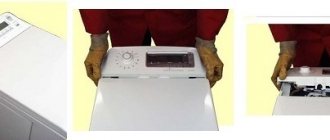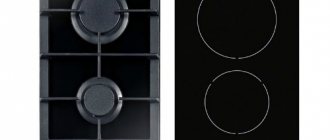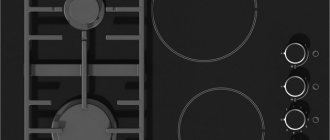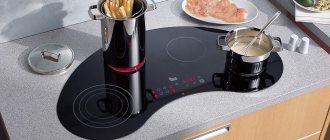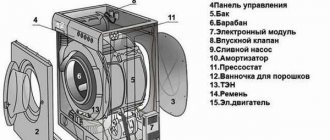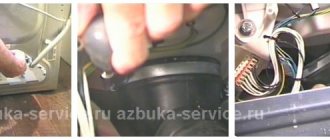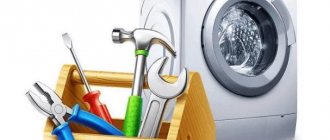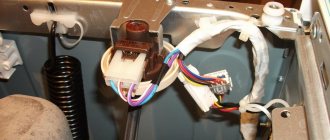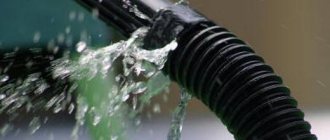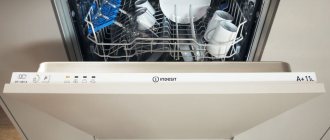What do you need for daily cooking? High temperature and ability to control the heat source. As it turned out, there are not many types of home “hearth”.
- kerosene burner - 5 decades ago it was the main element in any kitchen;
- a gas stove is by far the most popular “hearth”;
- electric stove - can be a separate element or a built-in component of the kitchen.
Let's consider the last option in more detail. When visiting the kitchen was an exclusively utilitarian matter (that is, the housewife was only interested in the process of cooking), no one thought about the appearance of the electric stove.
Accordingly, from a technical point of view, it was a very primitive device:
- frame;
- heating element (spiral or heating element in its own housing);
- thermostat (not present in every model);
- mechanical heating regulator (spiral resistance switch).
It was possible to repair such a stove with a screwdriver and pliers in hand. Even the heating coil was easy to make with your own hands: nichrome wire was wound around an ordinary pencil. More advanced craftsmen used an electric drill and a wooden mandrel. The steel rod was inserted into the chuck and the winding process was much faster.
Modern hobs
Then fashionable trends in modern design came to the kitchen, and simple electric stoves no longer fit into kitchen corners and furniture sets. Hobs have appeared that are built into the countertop.
Such household appliances are not only beautiful, they are distinguished by advanced functionality. The heating element is controlled using electronic controllers, and various security systems are present. Most products are equipped with touch control panels; you won’t find a mechanical handle even in economy class models. To repair a modern hob yourself, you need to have basic knowledge of electronics.
Types of heating elements of a modern electric stove
The usual spiral in ceramic insulator holders has not been used for a long time. Instead, 3 types of electric heaters are used, both direct and indirect:
- The HiLight direct heater is nothing more than a progressive descendant of the nichrome spiral. It is a corrugated tape made of high-resistance metals.
Looks and works exactly like a wire coil. However, due to the design, it releases thermal energy more efficiently and lasts much longer. Some manufacturers produce stoves with traditional wire heaters. There is no fundamental difference (slightly lower efficiency and reliability). But repairing a burnt-out spiral is easier. The dishes (and their contents) heat up very quickly. However, such a system has a serious drawback: it is difficult to regulate the degree of heating. In fact, the heater operates in two modes: “on” and “off”. This does not mean that it is impossible to set the operating temperature, it’s just that this process is implemented somewhat unusually. The electronic controller periodically turns off the power and turns it on again. In this way the amount of total thermal energy is regulated. In this mode, it is difficult to cook dishes that require “low heat”, as on a gas burner. Another problem characteristic of this type of hob is the high temperature of the decorative surface. Externally, the plane does not look hot, so there is a danger of touching and getting a thermal burn. - Direct heating emitters "HaloLight" are made in the form of ordinary incandescent lamps that heat dishes using infrared radiation. Probably everyone has tried to put their hand near a working car headlight: the warmth is clearly felt. Kitchen appliances use halogen emitters, which have the highest efficiency when generating heat. Such heaters operate according to an algorithm similar to HiLight, only the heating and cooling speed is much higher. Manufacturers often combine HaloLight elements with others in the same burner.
The possibility of burning your hand is the same as with the previous design, in addition, there is one more drawback. Halogen heaters have a limited lifespan, so repairs to hobs with such heaters occur much more often. - Indirect heating induction burners. They transmit energy in the form of an alternating magnetic field with a high frequency, causing the metal in their area of action to heat up. Technically they are designed like a regular inductor, only the turns are located in the same plane (for compactness).
The system operates on the principle of a transformer. The high-frequency generator generates the corresponding alternating current on the primary winding (coil located under the burner). The secondary winding is a utensil, which must be made of a metal with ferromagnetic properties, otherwise the magnetic field from the “primary” will work idle. Suitable steel or cast iron (can be checked with a magnet or by the presence of the “for induction cookers” icon). Copper and aluminum cookware will not heat up on such a burner. Eddy currents in the bottom of the cookware instantly heat the metal, and the pot or pan acts as a heating element (that’s why this method is called indirect). Without utensils, the hotplate remains cold, which reduces the risk of scalding. This can be clearly seen in the illustration:
You can adjust the degree of heating, but many housewives are confused by the restrictions on the material of the cookware. In addition, some buyers are wary of induction radiation. In vain, this is not a microwave: the electromagnetic field is no higher than that of a switched-on iron. And malfunctions can only be associated with the electrical circuit: the coil does not burn out. The main disadvantage of an induction burner is its high cost, which somewhat limits mass promotion to the masses.
Once you understand the design of heaters, you can repair your own hob.
Hob malfunctions
If one of the burners does not work, you can survive it. But the breakdown of the entire slab is already a problem. You can take the equipment to a workshop, but in addition to the cost of spare parts, you will be charged money for the work performed. If you know how to hold a soldering iron in your hands and have at least a multimeter, you can repair the hob yourself.
All faults can be divided into 3 groups
- Broken heating elements: For spiral or halogen burners, this is more of a mechanical problem than an electrical problem; the parts are completely repairable. In extreme cases (for example, a halogen heater) a simple replacement. The induction emitter (winding) does not break in principle; the problem may be in the electronics.
- Failure of switching elements or conductors. These can be relays, contacts, thyristor switches. They are not the most difficult elements to repair.
- Electronic circuits: generator, transformer, controllers, control unit. Without deep knowledge of electronics, it will not be possible to repair these elements. In the best case, you can dismantle the faulty element and install a new one.
Advice:
Before you begin complex repairs, try to diagnose “problems” that can be fixed without disassembling the structure.
For example, check the power supply from the input circuit breaker before connecting the direct power cable from the panel (including the socket, if any). The presence of power is checked with a multimeter on the contact block of the stove.
If the control panel does not work, check that it is dry (if there are movable keys) and clean (in the touch unit). Often a layer of dried splashes simply prevents the touch buttons from “feeling” your fingers.
How to disassemble the hob
The most commonly used panels are those built into the kitchen worktop. The electrical appliance has an independent body with a decorative plane, under which heating elements are located. Carefully remove the panel and place it face down on a flat surface. Before starting disassembly, it is recommended to disconnect the power wires. It would not be amiss to remind you that the wiring must be de-energized in advance.
After carefully removing the cover, we get full access to the “internal organs” of the panel. Any design has a similar layout: all electrical elements are located in the so-called working “trough” without dividing barriers. The illustration shows an option where “HiLight” type heaters are installed on all burners.
Already at this stage, it is possible to visually diagnose the integrity of the wiring and spiral (band) heaters. All blocks and modules are connected using connectors or contact terminals. Once the fault is localized, you can easily remove the unit for replacement or a more detailed check.
For example, you can remove a heater in an insulating casing, apply power to it, and check its functionality using the device.
Do-it-yourself hob repair: what to do if the burner does not turn on
If the burner does not turn on, there may be several reasons:
- burning or weakening of contacts;
- thermal relay malfunction;
- problems with the wires going to this burner;
- heating element burnout.
All these problems can be fixed with your own hands. Repairing a hob begins with disassembling . It must be unplugged and disconnected from the countertop. Transfer the hob to a table covered with a clean cloth, turn it glass side down, unscrew the fastening bolts located on the sides, carefully, holding the ceramics, turn them over and remove the ceramic panel. This way we get access to the insides and can repair the hob with our own hands.
We begin repairing the hob: remove the glass-ceramic hob
The first thing to do is to inspect the wires that go to the non-working burner, check the contacts . Violation of the integrity of the wires and burning of contacts is a very common cause of breakdown. In private homes, wiring can be chewed by mice, and contacts can burn due to poor quality assembly. If everything is visually in order, we pull the wires, checking the quality of the contact. If traces of soot are visible somewhere, we disassemble the contact, clean it to bare metal, pack it back, install it and clamp it well. The last stage of checking wiring and contacts is measurement. We take a multimeter, check the wires for integrity (we call) and for insulation breakdown (on the body and between each other). Read how to use a multimeter here.
If no deviations are found in the wiring, inspect the thermal relay . It is located next to the burner (electromechanical), covered with a plastic cover. In some models, the relays are located in the control unit (electronic). Then, in order to determine which relay is responsible for heating the burner we need, we track it through the wires.
On some models, thermal relays are installed on the control board
If the relay is electromechanical, pry off its cover with a screwdriver and inspect the contacts. There may be charred, bent or fused contacts. It must be replaced. If the relay is electronic, there is no point in opening it. We measure its resistance and compare it with the serviceable ones standing nearby. There is a deviation - a replacement is needed.
Read also: Series circuit resistance formula
If everything is fine with the relay, the burner may have burned out . To check, measure the resistance. If it is large or tends to infinity (break), the problem is in the spiral, heating element, etc. To find a replacement, look for the burner number (written on its body). With this number we go to the store or search on the Internet. Next, repair the hob - replacing the burnt burner. We unsolder all the wires, remove them, install a new one, and connect.
Repair of direct heating hob (individual components)
Diagnosis of faults is carried out from simple to complex. After the fuse, we check the electrical wiring and the functionality of the heating elements. Control of turning the heating filament on and off is carried out using PWM (pulse width modulation). Don't let this bother you. All the same, power supply is supplied by conventional relays, which are checked with a multimeter.
A burnt-out spiral (tape) is usually replaced entirely; this is not the most expensive element. As a temporary measure, a mechanical connection can be made (rivet or screw for tape, and screw terminal connection for helix). This will allow the stove to work for a while. This “joint” will last for several days, so buy a new spare part as soon as possible.
Power relays cannot be restored; they definitely need to be replaced.
The same applies to halogen heaters. Thermal elements are not repaired (in fact, this is an electric lamp), they are replaced with new ones.
As for burnt wiring, you should select a wire with similar characteristics, make a complete harness, and replace it using end switches.
Before reassembly, contact groups are checked for strength and absence of thermal damage, cleaned and reassembled.
If after checking it turns out that all power conductors and elements (including heaters) are in order, the electronics remain. Self-repair is possible only if you have specialized skills and a detailed electrical diagram.
If you know for sure that it is the electronic module that is not working, and there is no way to professionally diagnose it, you can take this particular unit to a branded workshop. It will be tested (for a small fee) on a stand, or in a similar model of hob. You can install a repaired or new unit in place yourself.
For information:
Some craftsmen restore the functionality of the hob by changing the control circuit. For example, you can power the heating elements from a homemade manual control unit located outside the main body. If the cost of restoring standard modules is too high, and the stove heats properly when connected directly, this method has a right to life.
Diagnostics and restoration of indirect heating panels
Repairing induction hobs can only be done by experienced electricians. Without knowledge of the material, with a simple multimeter and pliers, the operation is doomed to failure. At the same time, many problems are not malfunctions at all: a normal violation of the operating mode.
Typical malfunctions of induction heating systems
- The induction hob either does not turn on at all, or the power disappears immediately after starting operation. This may be a protective function: if you remove the dishes from the heating plane, or the size does not match the diameter of the burner, the automation blocks operation. The same applies to aluminum or copper cookware.
- The same problem (wrong cookware) can result in the induction hob not working at full capacity.
- The heater turning on independently may be due to contamination of the stove, or the presence of a massive steel (cast iron) object next to it.
Real malfunctions, not related to violations of the operating mode, appear in the inductive field generator circuit. As we have already noted, the winding fails extremely rarely.
Typical diagram in the illustration:
In fact, there is no space technology here. The transformer converts the supply voltage, and the generator creates an increased frequency of oscillations of the electromagnetic field. After a visual inspection (for obviously “burnt” radio elements), the generator is checked using a home oscilloscope. If you have such a device, there is no point in explaining the principle of checking the inductance generator; your level is sufficient for repair.
If you do not have sufficient experience, you will have to turn to the experts. In any case, repairing a separate unit will not cost as much as buying a new panel.
Find out the conditions for preferential repairs and the amount of your discount
You can get acquainted with all the details of repairing your household appliances, the cost of services, as well as ongoing promotions, current discounts, and preferential offers on our main page.
Over the years, we have accumulated extensive experience in the field of repairing household appliances. MasterByt is a high quality of service provision and responsibility to our clients! Trust your equipment to professionals!
Hobs help housewives, but they also add problems when they break down, causing serious disasters. In order to avoid situations in which our ancestors found themselves, deprived of a comfortable life, it is necessary to quickly eliminate equipment malfunctions and return pleasant predictability to our modern abode. We will tell you how to fix the panel with your own hands.
Electrical panel repair
Most often, users complain that the hob does not turn on. There are only two answers to the question “why did this misunderstanding happen to my equipment?”
1. no voltage in the outlet;
2. circuit break.
To check if the outlet is working, you can use a multimeter, which will show if there is voltage. A hairdryer or other compact electrical appliance is also suitable. The verification principle is simple: if the unit turns on, everything is fine with the socket, and the cause of the malfunction must be sought in the hob itself.
Circuit failure is a general name that combines a number of problems that cause the hob to malfunction. Among them are a burnt fuse and a broken contact, overheating of the sensor, or cable failure.
Read also: Gas convector with fan
Let's take a closer look at each of the emerging problems.
Some models have a high-fuse fuse. It easily burns out from power surges, taking on a “blow” that would otherwise affect the operation of the hob. If the kitchen helper fails for this reason, it’s not so bad: the fuses cost a penny, and any average professional can handle replacing them.
If one of the burners does not work, this situation is caused by broken contacts leading to the heating element. You can troubleshoot the problem as follows:
- Carefully turn the panel over;
- Inspect the contacts;
- If you find a break, solder the wires with a soldering iron.
If the hob does not work, you must carefully examine the condition of the cable. If you find breaks or damage, under no circumstances should you use such a unit, as this can cause a short circuit and cause the device to completely fail. Found a broken cable? Replace it with a new one or at least isolate the damage!
If the heating element fails, you should:
1. Purchase a new heating element;
2. Replace the failed part. It would be useful to remind you that this procedure can only be done when the panel is turned off. For this:
a) disconnect the terminals of the burnt-out heating element; b) take it out; c) install a new one; d) connect the contacts to it using connecting terminals.
A damaged sensor that does not “listen” to commands can be repaired yourself. This is done as follows:
- First you need to check whether the sensor is receiving contact. You can use a multimeter for this;
- If the problem is a broken circuit, use a soldering iron to reattach the broken wire.
Advice: leave the panel sensor repair to professionals.
Why does the unit crack? Chips and cracks “decorate” a glass-ceramic hob quite rarely, but they arise not without the fault of the user, who forgets the 2 basic commandments of operating the equipment: do not hit, do not overheat.
Sometimes breakdowns are “evidence” against the manufacturer’s dishonesty in the form of a violation of production technology.
It doesn't matter whose fault they happened. When there is an empty refrigerator in the house, and the hob ignores the wishes of the owner, an urgent question arises: how to replace the glass, and whether it is worth calling a specialist. The cost of a sheet of glass ceramics is approximately equal to the price of a new hob, so it is hardly advisable to carry out such a replacement.
Among other “whys,” hob users are interested in why it turns off on its own. Most often this occurs due to a violation of the integrity of the contacts. Alternatively, in touch models the main part “flies off”.
Induction hob repair
According to the induction principle, popular in cooking surfaces, heat is directed to the contents of the pan, rather than to the surface of the stove and utensils in which the dish is being cooked.
These devices, based on technological advances, most often break down like this:
The unit turns off immediately after turning on, or does not turn on at all
Induction provides low heat
The stove lives its own life, turning on by itself, even when there is no frying pan or kettle on the burner
The panel doesn't work at all
Most often, owners of induction panels are concerned about the complete failure of the stove to perform its functions: the kitchen assistant turns off after being turned on, or does not show any signs of life at all. Most often, this situation is caused by improper use of the unit. Simply, the smart panel recognizes the wrong utensils being used for cooking and goes on strike if you decide to cook food in a saucepan made from a material that is not suitable for the unit. Yes, size matters in this case too!
Tip: Do you want your induction hob to provide trouble-free operation? Use suitable pots and pans! The instructions for each product describe in detail which utensils can be used on a specific panel. Don’t neglect the advice, and you will be happy in the form of a delicious lunch!
The traditional children's riddle “it shines, but does not heat”, with the spread of induction panels received an unexpected answer: the surface and unsuitable cookware. Poor heating of the induction panel also falls under the category of errors caused by the wrong choice of cookware. The bottom of pots and kettles should be perfectly flat. Even millimeter-sized notches or concavities provoke a decrease in the performance of the unit.
Even more offensive, and even more dangerous, is the spontaneous switching on of the panel. Try the following in this situation:
1. Remove knives, forks, spoons, scrapers, foil - anything that contains metal from the cooking surface;
2. Wash the surface, completely removing salt deposits.
Did not help? The control unit is malfunctioning. You can’t do without a specialist here.
The complete absence of any signs of device viability has a number of reasons:
- No power at the outlet. You can check it using any electrical device, say, a coffee grinder.
- Blown fuse. To eliminate the malfunction, it is enough to replace the part.
- Broken contact in the circuit. In this case, it is advisable to contact a specialist.
Read also: How to measure cylinders with a bore gauge
Gas hob repair
Units that do not have sophisticated electronics are easy to repair, and in some cases problems can be fixed on their own.
The most common problems with gas-powered kitchen helpers are:
1. problems with gas ignition;
2. gas does not reach the burner.
If the gas does not ignite or ignites poorly, you must:
- Check the piezoelectric element for the presence of liquid or fatty deposits;
- Rinse and dry it;
- If this operation does not resolve the problem, check whether electricity is supplying the auto-ignition system. If the contacts are broken, the technician will solder them. You can do this yourself.
If the gas hob burners do not turn on due to lack of gas supply, do the following:
1. Check if the valve on the gas pipe is open. Found it closed? So open up;
2. Is there gas in the system, but is it not supplied to the burner? Clean the injectors. Remove any remaining food and fat from them. Wipe away any remaining moisture. Most often, this is enough to remove not too serious stains. If the nozzles are particularly dirty, a thick needle or awl will help.
Tip: Do you want your gas hob to live happily ever after, delighting you with trouble-free operation? Do not leave until later to clean up spilled liquids and pieces of food that fall out of the pan onto the panel during cooking. Removing dried and hardened evidence of culinary research will be more difficult later.
Most problems with cooktops can be avoided. All you need to do is follow the “commandments” of thrifty owners:
- follow the operating instructions;
- keep the device clean.
Minor faults can be eliminated on your own if you have previously had experience in repairing them, or the surface still requires replacement, and you “don’t mind” it. To repair an expensive unit, invite a specialist.
How to repair a hob, see here
The hob is one of the most important appliances in the kitchen, and like any other equipment, it is susceptible to breakdowns, but it’s quite easy to repair it yourself. If a malfunction is discovered during the warranty period, your stove will be repaired free of charge. But if the breakdown occurs several years later, you can try to repair the hob yourself, since contacting specialists may cost little less than buying a new stove.
In this article, our specialists have listed all the malfunctions of hobs and step-by-step disassembled the process of repairing faults with their own hands.
Causes of malfunctions
With the exception of a minimal percentage of real factory faults, most breakdowns occur due to improper connection and operation.
- Unstable mains voltage damages electronics;
- the use of cookware that does not correspond to the size of the heating surface leads to local overheating;
- Impacts and spilled liquid on a hot surface form cracks and chips through which moisture penetrates into the housing.
But still, the main reason for equipment failure is ignoring the requirements of the instructions.
Electric hob - common faults
During operation, equipment may malfunction due to voltage fluctuations, improper care or manufacturing defects.
Repair of a built-in electric kitchen hob is relevant in the following cases:
- The hob does not turn on. The phenomenon occurs due to a lack of voltage in the outlet or faulty parts. The socket is checked with a multimeter. If everything is fine with it, there are risks of fuse burning, contact breakage, cord chafing or squeezing, heating element breakdown;
- One or two burners on the hob are not working. The heater contacts that can be soldered have broken. The burnt-out heating element is replaced with a new one. If the contacts are broken, the control unit switch is repaired or replaced;
- The burner does not heat up well. The problem is due to overheating of the heating element, thermostat, or thermostat. Some parts are repaired, but the thermostat needs to be replaced;
- The fuse has blown. The failure occurs when the voltage fluctuates in apartments without ultrasonic systems on electric mains. The part is replaced, especially since its cost is inexpensive;
- the sensor does not work. The element is checked with a multimeter. If it does not respond to the device, the panel is changed completely. Sensor breakdowns occur due to improper operation of the stove or burnout of the control unit after cleaning with saline solutions;
- The hob gets very hot, works, and does not turn off. In 95% of cases the thermostat fails. The part is not repaired, but only replaced.
Read also: Homemade cyclone vacuum cleaner for sawdust
Glass on glass-ceramic surfaces sometimes cracks. The cause of the breakdown is a manufacturing defect or improper operation. Repair work is carried out exclusively by a master.
Important! Before inspection, electrical equipment must be disconnected from the network.
